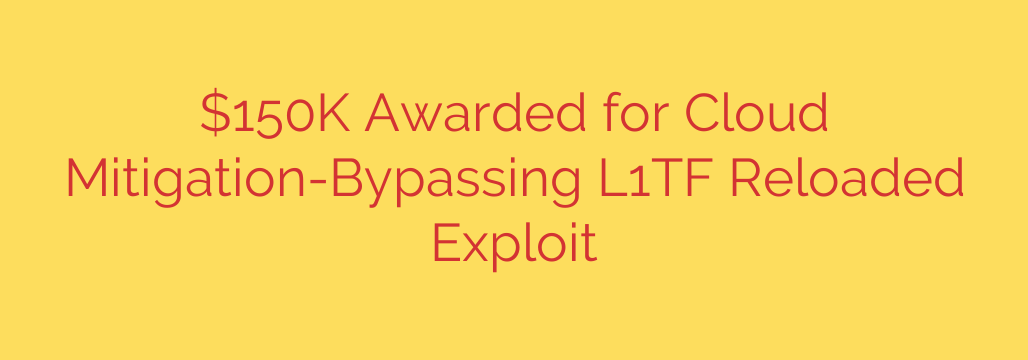
New ‘L1TF Reloaded’ Exploit Bypasses Major Cloud Security Defenses
In a significant development for cloud security, researchers have unveiled a new, sophisticated exploit that successfully bypasses existing mitigations for speculative execution attacks. This powerful vulnerability, dubbed L1TF Reloaded, targets a fundamental weakness in modern processors, posing a direct threat to the data isolation principles that underpin cloud computing environments.
The discovery was deemed so critical that it earned the researchers a $150,000 bug bounty award, highlighting the severity and ingenuity of the attack method. This new exploit is a successor to the infamous L1 Terminal Fault (L1TF) vulnerability, demonstrating that the initial patches and security workarounds were not foolproof.
What is L1TF Reloaded and Why Is It Dangerous?
L1TF Reloaded is a transient execution attack that leverages the L1 data cache in Intel CPUs. In a multi-tenant cloud environment, numerous virtual machines (VMs) from different customers often run on the same physical server. The core security promise of the cloud is that these VMs are completely isolated from one another.
This exploit shatters that promise.
By manipulating system page tables and cache states, an attacker in control of one VM can read sensitive data from the memory of another VM running on the same host CPU. This could include:
- Cryptographic keys
- Passwords and user credentials
- Proprietary business data
- Personal user information
The most alarming aspect of L1TF Reloaded is its ability to bypass the mitigations that were specifically designed to stop the original L1TF attack. This means that cloud providers and system administrators who believed their systems were protected are once again facing a serious cross-tenant data leak vulnerability.
How the Attack Bypasses Cloud Mitigations
Modern cloud infrastructure relies on a combination of software patches and hardware microcode updates to defend against speculative execution attacks. These defenses work by flushing sensitive data from caches or implementing stricter access controls.
However, the L1TF Reloaded technique employs a novel method to circumvent these protections. It creates a specific condition where the processor speculatively accesses data that should be off-limits and leaves traces of that data in the L1 cache. The attacker’s program can then infer the contents of this sensitive data, effectively creating a side channel for information to leak between supposedly isolated virtual environments.
The success of this exploit underscores the persistent challenge of securing complex modern hardware. The very performance-enhancing features that make processors fast, like speculative execution, can also open the door to creative and dangerous security breaches.
Recommended Security Measures and Actionable Advice
While the primary responsibility for patching this vulnerability at the infrastructure level lies with cloud service providers and hardware manufacturers like Intel, there are crucial steps that organizations and system administrators must take to protect their systems.
Monitor Vendor Advisories Immediately: Stay in constant contact with your cloud provider (e.g., AWS, Google Cloud, Microsoft Azure) and monitor their security bulletins. They will provide guidance on the status of their infrastructure and any actions required on your part.
Apply Patches and Microcode Updates Promptly: For on-premise data centers and private clouds, it is absolutely critical to apply the latest microcode updates from Intel and any corresponding operating system patches. Do not delay these updates, as a failure to patch leaves your systems directly exposed.
Review Instance and Tenant Isolation: Evaluate the sensitivity of the workloads you are running. For extremely sensitive applications, consider using dedicated hosts or bare-metal instances. While more expensive, this model ensures your workloads are not sharing physical CPU resources with any other tenants, completely eliminating the risk of cross-VM attacks like this one.
Embrace a Defense-in-Depth Strategy: A single vulnerability should not lead to a complete compromise. Ensure that strong encryption is used for data at rest and in transit, and enforce strict access controls and network segmentation to limit the potential impact of any single breach.
This discovery is a stark reminder of the ongoing cat-and-mouse game between security researchers and hardware designers. As systems become more complex, vigilance and a proactive patching strategy are no longer optional—they are essential components of modern cybersecurity.
Source: https://securityaffairs.com/182476/security/150k-awarded-for-l1tf-reloaded-exploit-that-bypasses-cloud-mitigations.html








